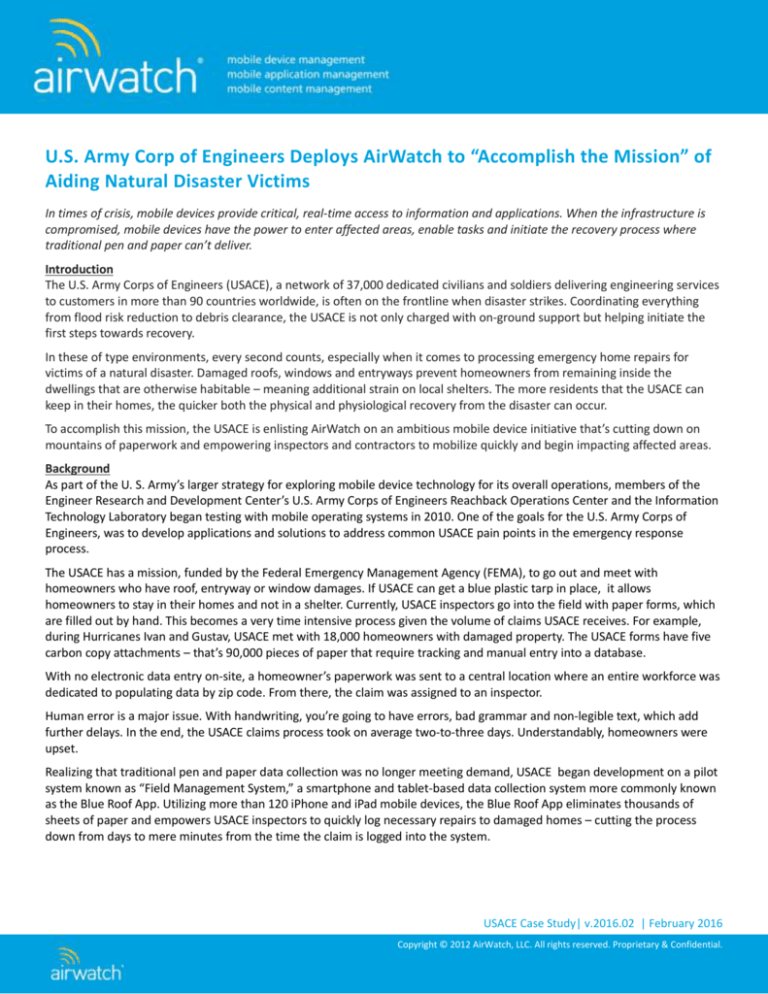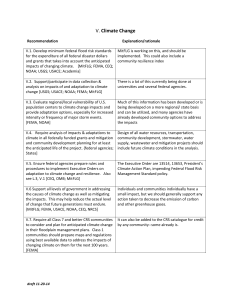
U.S. Army Corp of Engineers Deploys AirWatch to “Accomplish the Mission” of
Aiding Natural Disaster Victims
In times of crisis, mobile devices provide critical, real-time access to information and applications. When the infrastructure is
compromised, mobile devices have the power to enter affected areas, enable tasks and initiate the recovery process where
traditional pen and paper can’t deliver.
Introduction
The U.S. Army Corps of Engineers (USACE), a network of 37,000 dedicated civilians and soldiers delivering engineering services
to customers in more than 90 countries worldwide, is often on the frontline when disaster strikes. Coordinating everything
from flood risk reduction to debris clearance, the USACE is not only charged with on-ground support but helping initiate the
first steps towards recovery.
In these of type environments, every second counts, especially when it comes to processing emergency home repairs for
victims of a natural disaster. Damaged roofs, windows and entryways prevent homeowners from remaining inside the
dwellings that are otherwise habitable – meaning additional strain on local shelters. The more residents that the USACE can
keep in their homes, the quicker both the physical and physiological recovery from the disaster can occur.
To accomplish this mission, the USACE is enlisting AirWatch on an ambitious mobile device initiative that’s cutting down on
mountains of paperwork and empowering inspectors and contractors to mobilize quickly and begin impacting affected areas.
Background
As part of the U. S. Army’s larger strategy for exploring mobile device technology for its overall operations, members of the
Engineer Research and Development Center’s U.S. Army Corps of Engineers Reachback Operations Center and the Information
Technology Laboratory began testing with mobile operating systems in 2010. One of the goals for the U.S. Army Corps of
Engineers, was to develop applications and solutions to address common USACE pain points in the emergency response
process.
The USACE has a mission, funded by the Federal Emergency Management Agency (FEMA), to go out and meet with
homeowners who have roof, entryway or window damages. If USACE can get a blue plastic tarp in place, it allows
homeowners to stay in their homes and not in a shelter. Currently, USACE inspectors go into the field with paper forms, which
are filled out by hand. This becomes a very time intensive process given the volume of claims USACE receives. For example,
during Hurricanes Ivan and Gustav, USACE met with 18,000 homeowners with damaged property. The USACE forms have five
carbon copy attachments – that’s 90,000 pieces of paper that require tracking and manual entry into a database.
With no electronic data entry on-site, a homeowner’s paperwork was sent to a central location where an entire workforce was
dedicated to populating data by zip code. From there, the claim was assigned to an inspector.
Human error is a major issue. With handwriting, you’re going to have errors, bad grammar and non-legible text, which add
further delays. In the end, the USACE claims process took on average two-to-three days. Understandably, homeowners were
upset.
Realizing that traditional pen and paper data collection was no longer meeting demand, USACE began development on a pilot
system known as “Field Management System,” a smartphone and tablet-based data collection system more commonly known
as the Blue Roof App. Utilizing more than 120 iPhone and iPad mobile devices, the Blue Roof App eliminates thousands of
sheets of paper and empowers USACE inspectors to quickly log necessary repairs to damaged homes – cutting the process
down from days to mere minutes from the time the claim is logged into the system.
USACE Case Study| v.2016.02 | February 2016
Copyright © 2012 AirWatch, LLC. All rights reserved. Proprietary & Confidential.
Solution
USACE is eliminating the time delay. Instead of a clipboard and a pen, they are doing a system that is now more like an airport
ticketing model. USACE sets up kiosks that snap into place at a mobile command center. Homeowners can now walk-up, apply
for assistance on the iPad kiosk and that data is captured digitally the moment they sign their name. The iPad then assigns
assistance back to a server, which creates a longitude and latitude. The USACE inspector in that area receives a note on their
iPhone showing that they have been assigned a new case. Instead of 2-3 days with paper having to be sent, it only takes
minutes. The system does all the work.
To manage their mobile device fleet, the USACE relies on the proven security and visibility solutions powered by AirWatch. As
homeowners apply using iPads, the requests are instantly added to the Operation Blue Roof Command Center dashboard
where they are reviewed by USACE field managers and immediately assigned to USACE field personnel for initial inspection
using iPhones. Real-time charts, customizable based on vital information, displays the overall status of the mission. The charts
are updated with every transaction, and data can be exported via spreadsheet to any external data repository. The Common
Operating Picture dashboard, very similar to the configurable dashboard found in all AirWatch applications, is the command
center for the Field Management System. Once the form has been submitted, iPhones are then used by Quality Assurance
personnel to track inspection data, take photos, note damages and enter quantities of repair materials required which is then
populated online.
Following this, local contractors are given a special URL to the contractor portion of the USACE dedicated Blue Roof website.
When contractors are assigned repair requests, based on information entered by Quality Assurance personnel at the
command center portal, they instantly appear in the contractor assignment page. By clicking the “View/Update” link to the
right of the repair request, contractors can update the actual quantities of repair materials they used for a temporary repair.
Once this data is entered into the system, the repair is marked as complete and the record is archived in the command center
system.
Mobile Device Management is critical for USACE success in the field. In addition to the dashboard, USACE is currently testing
AirWatch Mobile Device Management capabilities to remote wipe devices, should they go missing, to ensure sensitive data is
not compromised for both the homeowner and the inspector. USACE also uses the devices as a communications tool for
mission leaders to locate and communicate with deployed response personnel. The USACE is accountable for the safety of
everyone we have on the ground; so, this is another way to ensure their safety while completing the task at hand.
Results
Leadership within the USACE, using applications gathered from claims submitted during the 2005 & 2008 hurricane seasons,
estimate that the Blue Roof App could save millions in costs related to time spent processing claims using the old system.
When the next disaster does occur, extensive field-testing gives the USACE confidence that the AirWatch solution will deliver.
USACE inspectors are claiming this will be the game changer in assisting homeowners during natural disasters because they
know response times have been cut down exponentially. It’s a win- win situation. The homeowners are cared for, and the
technologies take the onus off of the inspectors. In addition, the USACE responders log less time in the field, where debris and
other dangers reside, which helps ensure their safety. Homeowners aren’t used to getting service like this from the
government. They now experience state-of-the-art technology and interact with devices that they’re used to seeing.
Beyond the time-saving advantage, the Blue Roof App will also play a key role in reestablishing a sense of normalcy for the
victims. Consumers today expect a confirmation email, which is mentally comforting. The computer is doing the work but
psychologically, everyone feels better when they get that email saying their request is being taken care of. For the first time,
homeowners are going to get the same psychological benefits as receiving the confirmation that their application is being
processed and someone is diligently working on their case. That gives them hope… you can’t underscore the importance of
that in times of crisis.
USACE Case Study| v.2016.02 | February 2016
Copyright © 2012 AirWatch, LLC. All rights reserved. Proprietary & Confidential.









